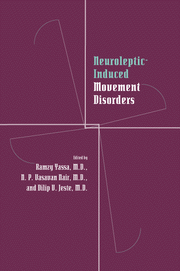Book contents
- Frontmatter
- Contents
- Contributors
- Preface
- Part I Historical perspective
- Part II Clinical aspects of tardive dyskinesia
- 2 Aging and tardive dyskinesia
- 3 Gender as a factor in the development of tardive dyskinesia
- 4 The Yale tardive dyskinesia study: a prospective incidence study among long-term outpatients
- 5 Vulnerability to tardive dyskinesia in schizophrenia: an exploration of individual patient factors
- 6 Tardive dyskinesia and affective disorder
- 7 Diabetes mellitus and tardive dyskinesia
- 8 Other factors in the development of tardive dyskinesia
- 9 Neuroleptic treatment and tardive dyskinesia
- 10 Anticholinergic drugs as factors in the development of tardive dyskinesia
- Part III Mechanisms underlying tardive dyskinesia
- Part IV Measurement of tardive dyskinesia
- Part V Tardive dyskinesia in different populations
- Part VI Other neuroleptic-induced movement disorders
- Part VII Treatment of tardive dyskinesia
- Index
7 - Diabetes mellitus and tardive dyskinesia
from Part II - Clinical aspects of tardive dyskinesia
Published online by Cambridge University Press: 09 October 2009
- Frontmatter
- Contents
- Contributors
- Preface
- Part I Historical perspective
- Part II Clinical aspects of tardive dyskinesia
- 2 Aging and tardive dyskinesia
- 3 Gender as a factor in the development of tardive dyskinesia
- 4 The Yale tardive dyskinesia study: a prospective incidence study among long-term outpatients
- 5 Vulnerability to tardive dyskinesia in schizophrenia: an exploration of individual patient factors
- 6 Tardive dyskinesia and affective disorder
- 7 Diabetes mellitus and tardive dyskinesia
- 8 Other factors in the development of tardive dyskinesia
- 9 Neuroleptic treatment and tardive dyskinesia
- 10 Anticholinergic drugs as factors in the development of tardive dyskinesia
- Part III Mechanisms underlying tardive dyskinesia
- Part IV Measurement of tardive dyskinesia
- Part V Tardive dyskinesia in different populations
- Part VI Other neuroleptic-induced movement disorders
- Part VII Treatment of tardive dyskinesia
- Index
Summary
In spite of considerable research, tardive dyskinesia remains an enigmatic syndrome: Its pathologic basis is not understood, the role of neuroleptic treatment in its pathogenesis remains controversial insofar as chronic schizophrenic patients are concerned, and it is not clear why, with comparable exposures to neuroleptics, some patients develop the syndrome and others do not. It seems unlikely that this differential risk pattern can be explained by pharmacokinetic considerations alone. Also, the search for patient characteristics associated with greater risk for developing tardive dyskinesia has yielded largely disparate findings. Indeed, increasing age is the one factor that has consistently been associated with higher incidences and prevalences, increased severity, and stubborn persistence of tardive dyskinesia.
Diabetes Mellitus and Tardive Dyskinesia
On the basis of incidental observations and findings from pilot studies, we earlier hypothesized that impaired glucose metabolism is associated with increased risk for tardive dyskinesia (Mukherjee et al., 1985; Mukherjee, Bilder, & Sackeim 1986). That view was based on the following observations: (1) In two separate studies, the proportion of tardive dyskinesia patients also diagnosed as having non-insulin-dependent diabetes mellitus (NIDDM) was considerably higher than would have been expected on the basis of the known rates of NIDDM in the general population (Mukherjee et al., 1985, 1986). (2) On average, fasting blood glucose concentrations were found to be significantly higher in patients with tardive dyskinesia than in patients without tardive dyskinesia, an effect that remained significant after controlling for variance due to age and gender (Mukherjee et al., 1985).
- Type
- Chapter
- Information
- Neuroleptic-induced Movement DisordersA Comprehensive Survey, pp. 82 - 98Publisher: Cambridge University PressPrint publication year: 1996
- 1
- Cited by

